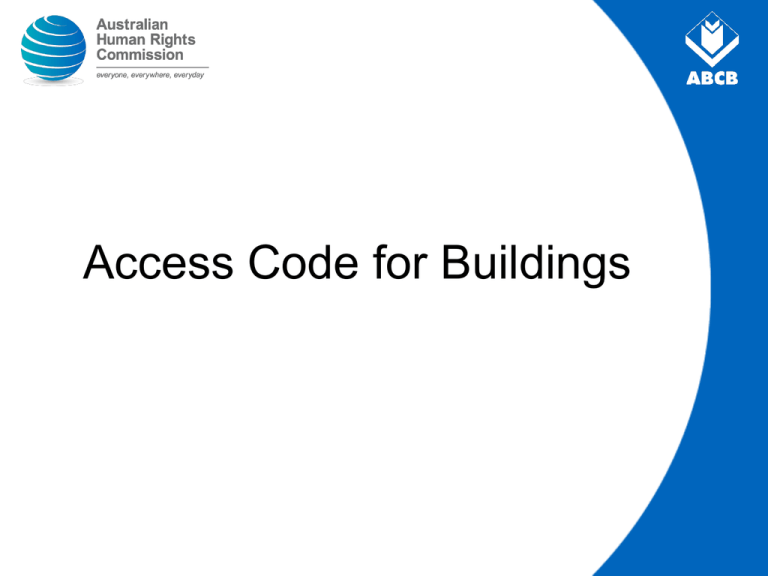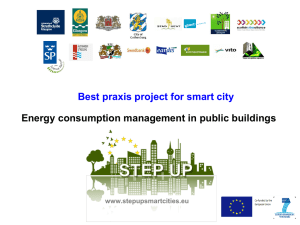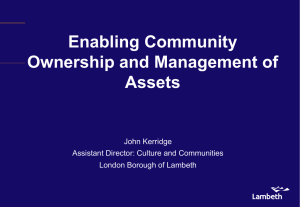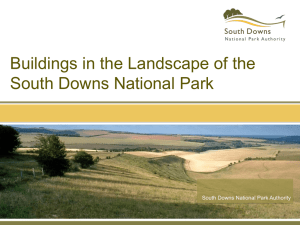Part 2 (large file 6MB PPT)
advertisement

Access Code for Buildings Access Code for Buildings • Schedule 1 of the Premises Standards • Equivalent to proposed BCA provisions • Like the BCA, the Access Code is performance based minimum requirements • Compliance can be by meeting Deemed-toSatisfy Provisions or Alternative Solutions that can be demonstrated to meet the Performance Requirements Part A1 – Definitions • Some definitions repeated from current BCA, e.g. “aged care building” • Some existing BCA definitions changed, e.g. “accessway” • Some new definitions, e.g. “luminance contrast” • Defined terms are italicised where used in provisions Part A2 – Adoption of standards • 2009 editions – AS 1428.1 – General requirements for access – New building work – AS/NZS 1428.4.1 – Means to assist the orientation of people with vision impairment - Tactile ground surface indicators – AS/NZS 2890.6 – Off-street parking for people with disabilities Current – 800 mm Proposed – 850 mm Part A2 – Adoption of standards • Public transport buildings – Part H2 references different versions of standards to those in the remainder of the Access Code – Refer to Table 1 to determine which standards apply to which provisions Part A4 – Building classifications • Repeated from the current BCA, but with one change .... • Class 1b now includes “4 or more single dwellings located on one allotment and used for short-term holiday accommodation” Table D3.1 – General access requirements • Buildings and parts of buildings must be accessible as required by Table D3.1 (unless exempted by D3.4) • Table D3.1 describes the extent of access to be provided for each class of building Class 1b buildings • Small hostel, guest house, B&B – access to 1 bedroom and 1 of each type of common room or space • 4 or more holiday cabins on one allotment – Access to at least 1 dwelling and increasing on a sliding scale Class 2 buildings • Flats, apartments, units – Only to front door of units on one level (or on all levels served by a ramp or lift) and one of each type of room or space used in common such as laundry or BBQ area – Note BCA proposal is to cover all new Class 2 buildings Class 3 buildings • Large hostel, boarding house, motel – To the front door of units on at least one level (or on all levels served by a ramp or lift) – To at least one of each type of room or space used in common including a swimming pool, dining room, TV lounge, etc. – Access to at least 1 unit and increasing on a sliding scale – Not more than 2 accessible units next to each other – If more than 2 accessible units required, must be representative of range of rooms available Total rooms Accessible Rooms Current BCA Access Code 10 1 1 20 1 2 30 2 2 40 2 2 50 3 3 100 4 5 200 8 9 500 18 19 Class 5, 6, 7b, 8 buildings • To and within all areas normally used by occupants Class 7a buildings • Carpark buildings (but not private garages) – To and within any level containing accessible carparking spaces Class 9a buildings • Hospitals, health-care buildings – To and within all areas normally used by occupants Class 9b buildings • Schools and early childhood centres – To and within all areas normally used by occupants • Assembly buildings (public halls, cinemas, sports stadiums, etc.) – To wheelchair seating spaces required by D3.9 and other areas normally used by the occupants, but not tiers or platforms if no wheelchair seating spaces on those levels Class 9c buildings • Aged-care buildings – Essentially the same as Class 3 buildings – To the front door of units on at least one level (or on all levels served by a ramp or lift) – To at least one of each type of room or space used in common including a swimming pool, dining room, TV lounge, etc. – Access to at least 1 unit and increasing on a sliding scale Class 10 buildings/structures • Class 10a (non habitable building such as public toilet block or shelter) – Requirements do not apply to a facility that is not in an “accessible area” or those not intended for public use – To an accessible sanitary facility, change room and shelter • Class 10b (swimming pool) – To and into a pool with a total perimeter greater than 40m associated with a Class 1b, 2, 3, 5, 6, 7, 8 or 9 building (note acceptable methods of providing access into pool vary according to size of pool – see D3.10) D3.2 Access to buildings • Main changes: – Through the principal pedestrian entrance and not less than 50% of all entrances (including principal) – If building has a total floor area of more than 500 square metres an inaccessible entrance must be no more than 50 metres from an accessible one. – Specific requirements for single entrances with multiple doorways and door leaves D3.3 – Parts of buildings to be accessible • Main changes: – Every stairway and ramp (other than fire isolated) must comply with clause 10 and 11 of AS 1428.1 – Fire isolated stairways must have luminance contrast nosing strips D3.3 – Parts of buildings to be accessible • Main changes: – Passing spaces every 20 m where direct line of sight not possible – Turning spaces 2 m before end of a accessway and every 20 m on an accessway – Levels other than entrance storey need not be provided with lift or ramp in buildings with no more than 3 storeys and where the upper floors are less than 200 square metres each 200 m2 max Max. 3 storeys 200 m2 max D3.4 - Exemptions • Access not required where: – Inappropriate because of particular purpose the area is used for; or – Area would pose a health or safety risk for people with a disability • Examples could be loading docks, foundry floors and rigging loft – assessment on a case by case basis D3.5 - Accessible carparking • Essentially no change to current BCA requirements for number of carparks (except increase for clinics and day surgeries) • Changes to layout and dimensions in AS/NZS 2890.6 2400 2400 Accessible space 2400 Accessible space 5400 Bollard Shared areas Parking aisle or roadway 2400 D3.6 - Signage • Main changes – Improved signage about type of hearing augmentation system used and where receivers can be obtained (if used) – Signage indicating right or left hand transfer in accessible toilets – Signage indicating ambulant accessible toilets • Part D4 (Specification D3.6) provides details on requirements for design and installation of Braille and tactile signs D3.7 – Hearing augmentation • Main changes – Removal of the 100 square metre room size concession – Increased area coverage for induction loop system from 15% to 80% of area – System using receivers must cover 95% of the area and receivers must be provided as a ratio of the number of occupants on a sliding scale D3.8 – Tactile indicators • Essentially no change other than referencing recent AS 1428.4.1 technical requirements D3.9 – Wheelchair seating spaces in assembly buildings • Main changes – Increased number of wheelchair seating spaces – Location and grouping specified to provide seating options including restrictions on how many wheelchair seating spaces can be located in front rows of cinemas D3.10 – Swimming pools • Specifies the means of access/exit to swimming pools including fixed or movable ramp, zero depth entry, platform lift or slingstyle lift • Where swimming pool is over 70m perimeter at least one means of entry must be a ramp, zero entry or platform lift • Part D5 (Specification D3.10) provides details on the design and installation of the different means of entry/exit to a swimming pool • Note that latches for swimming pool gates need not comply with AS 1428.1 D3.11 – Ramps limitation • A limitation on the use of ramps has been introduced whereby a series of connecting ramps cannot rise more than 3.6m • Restrictions on overlapping landings D3.12 Glazing on an accessway • While this is no change from the current BCA the referenced AS 1428.1 (clause 6.6) has made it clearer that markings on glazing must be across the whole width, solid and a minimum of 30% luminance contrast Part E3 – Lift installations • Introduces a wide range of lift options with limitations on use • Specifies features that each type of lift must have • Note that unenclosed lifts may use constant pressure devices for operation (for 5 year review) Part F2 – Sanitary facilities • Generally a unisex accessible toilet must be provided on every storey where there are toilets • If more than one block of toilets on any floor then unisex accessible toilets at 50% (for 5 year review) • Ambulant accessible toilet in addition to unisex accessible toilet • Left and right handed facilities where more than one • Clarifies washbasin and fixtures must be inside facility • Increased circulation space required in AS 1428.1 900 mm min 900 to 920 mm Part H2 – Public transport buildings • Transferred from the Disability Standards for Accessible Public Transport • Provides requirements for passenger use areas of public transport buildings and timetable for compliance of existing buildings • Where H2 requires different compliance targets they take precedence Summary • Awareness raising, not full technical details • Explanatory Statement provides information on intent (available online) • Follow-up questions to assist in developing further material, please forward to AHRC Questions? http://www.ag.gov.au/premisesstandards michael.small@humanrights.gov.au www.humanrights.gov.au www.abcb.gov.au









